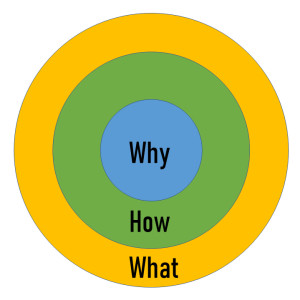Need Step
As opposed to the speech to inform, the first main point must serve as the Need step. Here speakers will frame a need for their audience so that they can follow it up with a satisfying solution (i.e., the action they will propose later in this speech). Also referred to as the “problem step,” this main point involves explaining the why behind the proposed action.
In September of 2009, Simon Sinek, an author and speaker in business and leadership studies, gave a TEDx talk in the Seattle area, where he presented the idea of what he dubbed “The Golden Circle.” To explain this, Sinek used the following diagram:

Using this model, Sinek explained that the majority of persuasive messages that people see, read, or hear on a regular basis work from the outside inward. They start with the what, or the result, and then explain the how, which represents their method or product, but stop there, expecting people to buy into their idea, their services, or their products. The examples Sinek used in his speech included: “Here’s our newest model of SUV (what). It has dual airbags, great gas mileage, and looks sharp (how).” Sinek went on to explain that these messages fail because they come across as uninspiring. They do not tap into the decision-making center of the brain—the limbic system—because they fail to inspire or engage by explaining why people need to buy this product.
Sinek then went on to describe the model used by Apple, which uses a highly successful persuasive model because it works from the inside out. As a company, Apple’s messages clearly begin with an explanation of why they conduct business by communicating with the world that, in everything they do, they believe in challenging the status quo and thinking differently. Only after Apple finishes explaining the why do they state that they achieve this goal by creating products that are beautifully designed, easy to operate, and challenge the limits of technology (how). Apple’s message then ends with the what by showing its audiences the products they can expect to benefit their lives.
In motivating an audience to action, speakers must tap into their audience’s why by explaining to them that a genuine and relatable need exists. They can complete this task by addressing the Need step in four components:
- Show the audience that a need or a problem exists and that it can and will affect each and every member of the audience in some way.
- Explain to the audience why it exists by providing context and history behind the need or problem. In other words, explain where the need arose and perhaps why nothing has been done about it until now.
- Demonstrate to the audience that this problem needs to be solved or this need must be addressed immediately—that it will not simply disappear on its own if left alone.
- Overcome potential objections. Why might the audience not believe that this need or problem affects them personally?
Returning to the example speech from earlier, the breakdown could look as follows:
Need Step
- Texting and driving is an all too common occurrence on our roads today.
- Using mobile technology to stay socially connected to others is remarkably addictive, according to a study performed by Dr. David Greenfield, founder of the Center for Internet and Technology Addiction, when cell phone users compulsively check their devices it is in an effort to stimulate the brain’s pleasure centers.
- In this way, cell phone use can be compared to gambling or gaming addictions, making even the most moral person succumb to the temptation of glancing down at a recently received notification.
Note: This half of the Need step provides the audience with context and background, effectively setting up the problem. Additionally, it shows the audience that the problem will not go away.
- Texting and driving drastically reduces driver attentiveness and creates life-altering hazardous driving conditions.
- According to a recent study, the average person glances at their phone for 5 seconds to check a message, while the average texting-related crash occurs within only 3 seconds of driver distraction.
- According to the Virginia Tech Transportation Institute, texting while driving is six times more likely to cause an auto crash than driving when intoxicated.
Note: This half of the Need step relates the problem to the audience, while also demonstrating a severe and life-threatening need to address the problem immediately.

